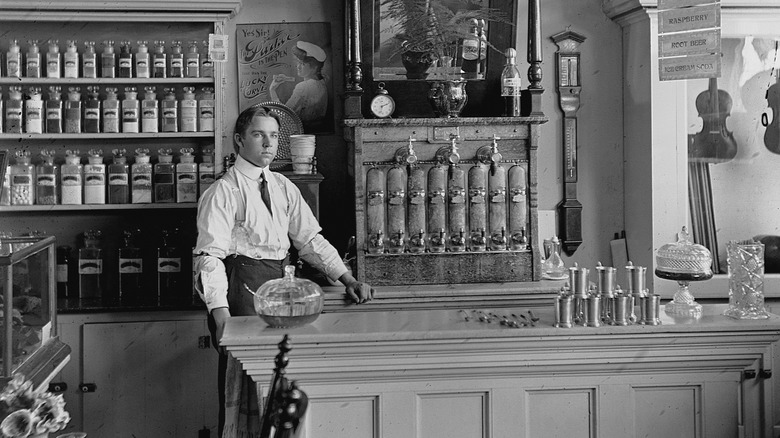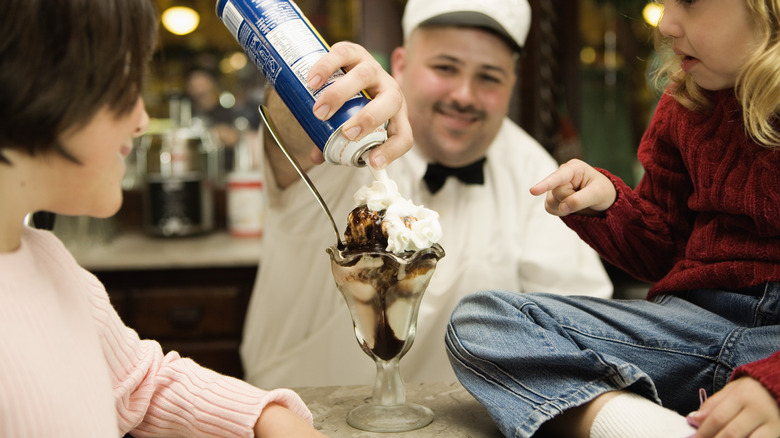Ice Cream Sundaes Were Invented Because Of A Bizarre Law
The ice cream sundae seems like a pretty universally beloved treat, at least in the United States. How could ice cream, a silky and delicious sauce (chocolate, strawberry, or caramel), whipped cream, and a maraschino cherry be anything other than alluring? Well, once you dig into the subject, you'll discover that the treat's history is just as intriguing. There are nearly as many origin stories, birthplaces, and alleged inventors as there are Baskin-Robbins flavors. Besides causing less than sweet civic rivalries, there's pretty solid evidence that the sundae was invented to get around the law.
At the turn of the 19th century, many states had religion-based blue laws, which forbade certain activities on Sundays, like selling liquor or dancing. Strangely, some places even banned selling soda on Sunday. Since ice cream sodas — drinks that are similar to what we call "floats" today but feature cream and flavored syrup — were all the rage, this prohibition began cutting into soda fountains' business. At least one wily druggist figured out a way around this law by removing the soda from the dessert so that it was just syrup and ice cream, and thus legal to sell. In fact, there are at least two origin stories with this specific detail from Evanston, Illinois, and Cleveland, Ohio.
The 'no soda on Sunday' law led to the sundae, but where did it actually come from?
The best-known version of the sundae's birth is from Evanston, Illinois, a Methodist stronghold with strict blue laws. After the city banned the sale of soda on Sundays, either William C. "Deacon" Garwood or Newton P. Williams — historians debate the pioneer — came up with the simple solution of removing the soda from the treat in order to comply with the law. A similar story comes from Cleveland, Ohio. In this version, the inventor topped ice cream with fruit that he called the "fruit Sunday" to bypass the local blue laws, according to the 2002 book "Sundae Best: A History of Soda Fountains" by Anne Cooper Funderburg.
In both stories, the sundae became popular enough locally to spread to Chicago — and across the country from there, eventually becoming a classic American dessert. In fact, the hot fudge sundae was one of Marilyn Monroe's favorite foods, along with broiled meat and raw carrots. Even famed cook Julia Child served a version of this treat to her dinner guests: a sundae made with ice cream, bourbon, and a sprinkle of instant coffee. This version definitely wouldn't have flown with religious-minded town fathers, though.
Why aren't ice cream sundaes spelled like 'Sunday'?
Other towns and cities also claim to be the true birthplace of the sundae, including New Orleans, Louisiana, and Buffalo, New York. Perhaps the biggest rivalry concerning bragging rights to the sundae, though, is between Two Rivers, Wisconsin, and Ithaca, New York. Two Rivers claims a local druggist invented the treat way back in 1881. The city even has a museum and statue commemorating the birth of the sundae. Meanwhile, Ithaca alleges the sundae was born there in 1892 and has evidence in the form of old newspaper advertisements for the treat. These cities even have their own songs that reject the other's claims.
Finally, even the dessert's interesting spelling is something of a mystery, though it may also be related to blue laws. Many historians believe the name was changed to steer clear of the church since religious-minded folks felt using "Sunday" to sell a product was sacrilegious.
Now that you've learned a bit about the hidden history of this famous American treat, try this ultimate sundae you can make at home that includes Sichuan peppercorn hot fudge and jackfruit compote. Dig in!


